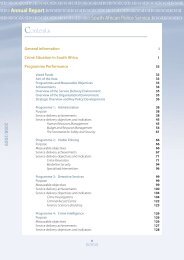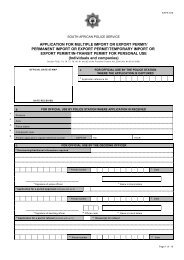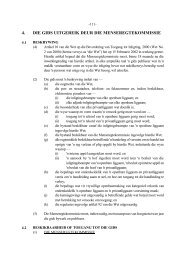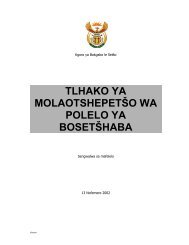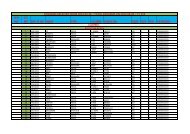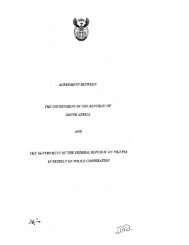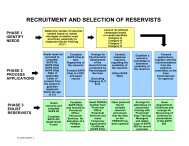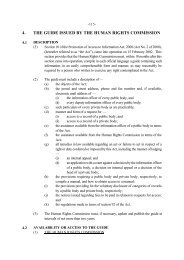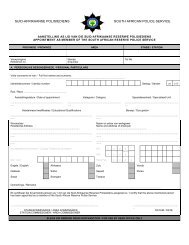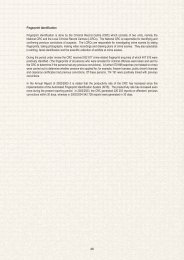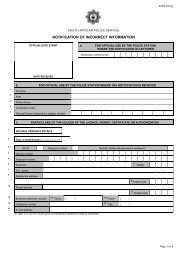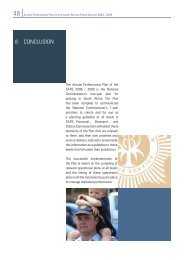Part 13 - Saps
Part 13 - Saps
Part 13 - Saps
Create successful ePaper yourself
Turn your PDF publications into a flip-book with our unique Google optimized e-Paper software.
319<br />
local government and any other person, group or organisation which can play an active<br />
role in, or support, the Rural Protection Plan. 33 Other functions of the Priority Committees<br />
for Rural Safety include: coordinating all security related actions relating to rural<br />
protection; identifying factors that have a negative influence on the safety of the farming<br />
community; distributing relevant information; and providing feedback on the Rural<br />
Protection Plan to all relevant role players. 34<br />
The available statistics on farm and smallholding attacks indicate that over the four years<br />
after the launch of the Rural Protection Plan in late 1998 the number of recorded incidents<br />
increased (albeit to a greater extent in respect of attacks on smallholdings). During the<br />
same period, however, the number of recorded murders associated with farm attacks<br />
stabilised at between 140 and 150 per year, which means that, relatively speaking, the<br />
murder rate declined. 35 It needs to be borne in mind, however, that the number of murders<br />
recorded in South Africa as a whole has been declining since 1994.<br />
The point has been made that the Rural Protection Plan’s success varies from one<br />
geographic area to the next. 36 Generally the SAPS and the SANDF (as well as the<br />
police reservist structures and the SANDF’s Commandos) cooperate and assist each other.<br />
However, civilian participation – especially among farm workers – is inadequate. The state<br />
security forces are too thin on the ground in the country’s rural areas to prevent farm and<br />
smallholding attacks in any meaningful way. More extensive civilian participation is<br />
consequently crucial if the plan is to succeed.<br />
The Commandos<br />
The commandos (officially called the ‘Territorial Reserve Force System’) play an integral<br />
part in the Rural Protection Plan. Members of the public can belong to one of three types<br />
of Commando structures:<br />
Area bound reaction force commandos: These are generally staffed by people who live in<br />
urban areas. In an emergency the local commando to which they belong can call them up<br />
for duty. Having been called, such commando members are issued with a rifle and<br />
uniform, which they have to return once they are booked off duty. These commando<br />
members are paid for the hours they work. Area bound reaction force commando members<br />
are trained jointly with police reservists to conduct patrols, roadblocks, follow-up<br />
operations, cordon and search operations, and farm visits. 37<br />
Home and hearth protection reaction force commandos: These are staffed by farmers and<br />
smallholders, and their workers. Members of this type of commando are responsible for<br />
assisting other farmers and smallholders in their district only if a farm or smallholding<br />
attack has occurred. Such commando groups then go into action (for example, setting up<br />
33 Interview with Lt. Col. H.J. Boshoff, National Operational Coordinating Committee, Pretoria, 20 April<br />
1999.<br />
34<br />
National Operational Coordinating Committee crime prevention and response service, National<br />
Operational Coordinating Committee document, Ref. NOCOC/3/9, 29 September 1998, p 5.<br />
35 See p 23.<br />
36 Schönteich M. and Steinberg J. Attacks on farms and smallholdings. An evaluation of the Rural Protection<br />
Plan (Institute for Security Studies, Pretoria, 2000) p 87.<br />
37<br />
National Operational Coordinating Committee crime prevention and response service, National<br />
Operational Coordinating Committee document, 29 September 1998, Ref. NOCOC/3/9, p 6.



